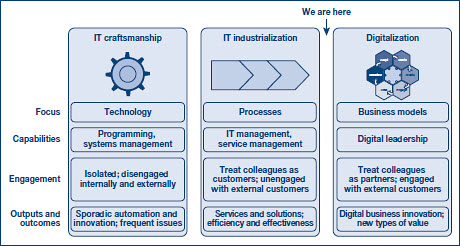Research: CIOs and the 'digitalization' of business

Cloud, mobile, social, and analytics are modern buzzwords symbolizing a broad shift toward Internet-based business and consumer software. More fundamentally, this shift implies the need for companies to adapt business models and processes in response to a world that increasingly wants to do business online.
Gartner's new state of the CIO report for 2014 calls this trend the "digitalization" of business. Despite the unwieldy terminology, Gartner's report makes an important point — cost cutting and improving efficiency are critical goals for IT, but are no longer the absolute measures of IT success.
Gartner calls the digitalization of business a "third era of enterprise IT," following a period in which IT strived to standardize processes and deliver services efficiently. The following diagram, from a summary (PDF) of the Gartner report, illustrates the progression toward a world in which IT innovation supersedes efficiency as the primary metric:

The report supports this view with data showing a gradual increase in expectations around growth and innovation that management has for the CIO and IT. Importantly, management expectations of CIO integrity, effectiveness, and efficiency have remained essentially constant from 2009-2014:
The shift Gartner describes did not suddenly materialize. Gartner presented the same trends in its 2013 CIO agenda report, summarized in the firm's recommendations last year:
Talking with many Chief Information Officers, I see two types of CIOs emerging as a pattern: infrastructure CIOs and innovative CIOs. Although any good CIO should be concerned with both infrastructure and innovation, many CIOs tend toward one side or the other.
Research from CIO Magazine's State of the CIO 2014 survey confirms this view:
the alarming split in the profession--between CIOs at the top of their game and those who aren't--will alter careers, and perhaps corporate futures as well. There are glaring differences in what the CEO wants this year from each kind of CIO. Cost-center CIOs must finish a major enterprise project, simplify IT and cut technology spending by a set percentage. Game-changers are being asked to lead product innovation efforts and enable global expansion.
There is a polarization to what's happening
During my CxOTalk conversation with the author of last year's Gartner CIO agenda report, Marc P. McDonald, he offered advice for bridging the gap between infrastructure and innovation:
Turning sparks into flame and growing that flame requires a scalable, very capable platform. That's what the CIO brings to the table. The most powerful combinations we've seen are the CIO and CMO working together with a shared goal to grow the business. When my goal is to grow the business, everybody has the potential to win. When my goal is to control costs, there is automatically a system of winners and losers.
Of course, bridging the innovation gap requires management support to drive the organizational changes that are usually necessary. Unfortunately, that support is not always forthcoming. During a recent conversation with the CFO of a public company, I suggested treating IT as a center for innovation. This CFO rebuffed the suggestion, making clear that cost reduction is his primary goal for IT. This story paints a realistic picture of present-day relationships between management and the CIO in many organizations.
Although companies vary in their capacity and interest to engage in digital transformation (see Esteban Kolsky's primer), the transition to customer-centric models of innovation is well under way.